The delicious smell of fresh-baked German rye bread in our home is indescribable. The thick and hard crust and the soft squishy inside of the bread are the defining characteristics of this German-style rye bread. It is a staple in German cuisine – a slice of rye bread goes well with cold meats, cheese, frikadelle, schnitzel or some soup. Learn how to make it at home with this easy German rye bread recipe.
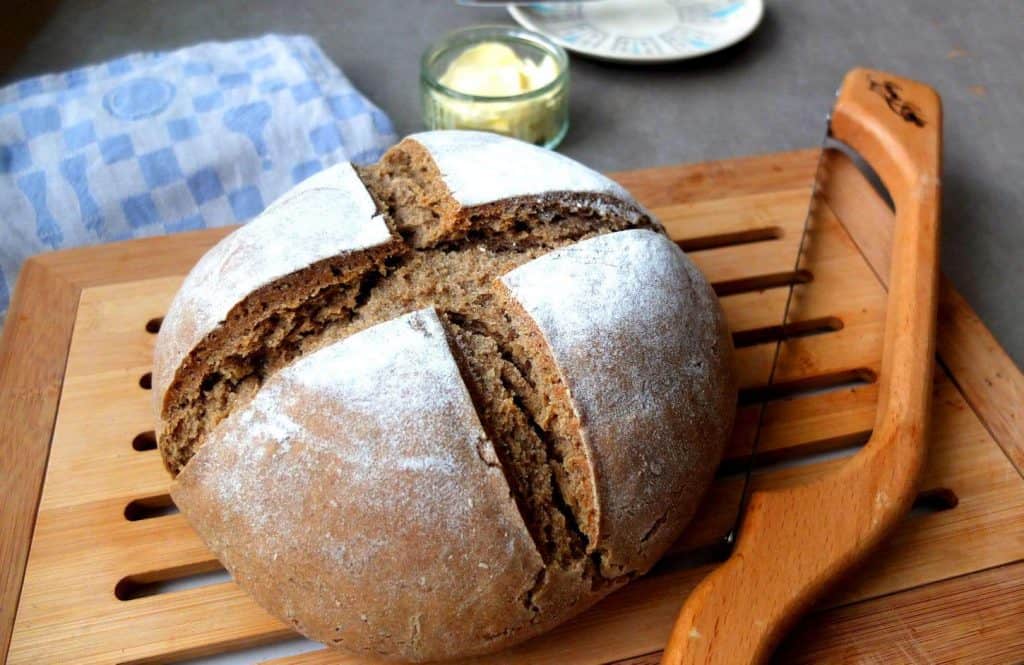
I missed rye bread a lot when living in the UK. Do not get me wrong, I really miss British bread now that I live in Germany as Toastbrot does not taste near as good as British bread. I am still searching for the perfect bread for a bacon sandwich in Germany.
About bread in Germany
There are about 300 different types of bread in Germany. The most popular type of bread is a “Mischbrot”, which is made with a blend of rye and wheat flour (32.8%), in second place is toast bread with 20.3%, then seeded bread (15.2%), whole-grain bread (10.5%) and then pure wheat and rye bread (5.2) [source brotinstitut.de]
Bread is a serious business in Germany. To quote my uncle, a retired German baker, who was interviewed by the New York Times in 1998: ''There used to be a test for young German women,'' Mr. Junemann said, looking over the glasses perched on the end of his nose, blue eyes dancing. ''If they couldn't cut a loaf of bread evenly, they couldn't get married.'' [source: new York times; The Miracle of Rye; In Germany, and among some here, rye bread is a spiritual thing.] - I am pretty sure that is not the case any more!
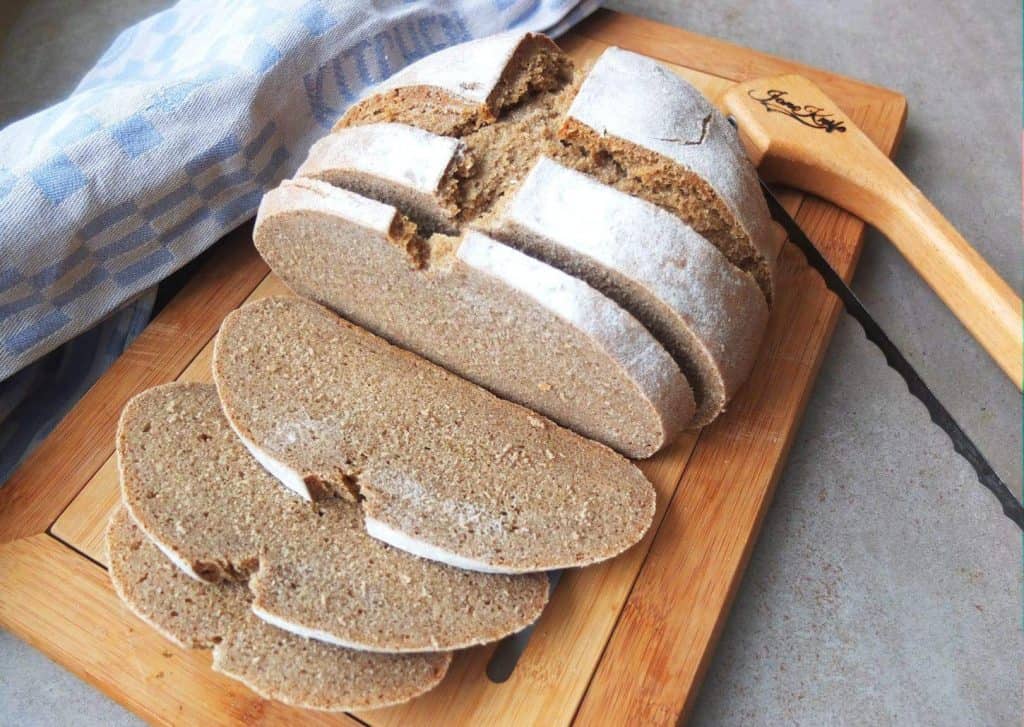
What is German rye bread?
Rye bread in German is called Roggenbrot.
Rye bread in Germany is bread that is made from a minimum of 90% rye flour. Any bread with a lower percentage of rye flour is called Mischbrot (mixed bread).
Germans eat their rye bread with salami, cold cut sausages, cheeses and spreads.
Is rye bread healthy?
Rye bread is not only delicious but also healthy. Rye bread is higher in fibre than white bread and contains more nutrients such as zinc, pantothenic acid, phosphorus, magnesium, calcium, and other micronutrients. In addition, German rye bread tends to be more filling, and so affects the blood level sugar to a less extent than white bread.
Does rye bread contain gluten?
German rye bread does contain gluten, so while it is suitable for someone trying to avoid wheat, it is not suitable for people with gluten intolerance.
The higher gluten content in rye flour may lead to bloating with some people.
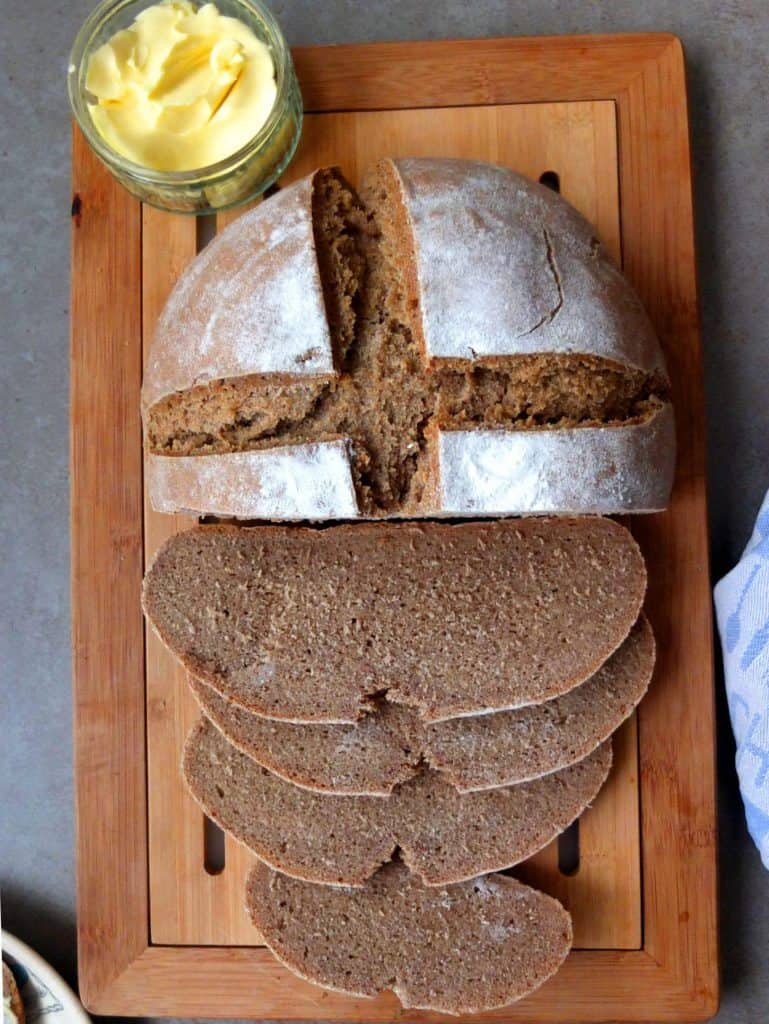
How to make German Rye bread
Ingredients:
- 430 g (15 oz) white rye flour
- 220 g (7.7 gr) wholegrain rye flour
- 50 g (1.7 oz) wheat bread flour
- 7 gr instant yeast (one packet or 2 tsp)
- 1 tablespoon vegetable oil
- 2 teaspoon salt
- 450 ml (15.2 fl oz) lukewarm water
- 1 tablespoon white wine vinegar or cider vinegar
German rye bread spices
- 1 tsp ground caraway seeds (optional)
- 1 tsp ground corriander (optional)
German rye bread recipe
- Preheat your oven to the lowest setting (mine is about 50 degrees Celsius)
- Combine the white rye flour and wholegrain rye flour, wheat flour, water, yeast, vinegar and salt in a bowl. With a stand or hand mixer knead the dough for around 5 minutes.
- Form the dough into a ball. Slightly grease a bowl with oil (this will prevent the dough from sticking to the walls of the bowl later). Place the dough ball into the bowl and cover with a tea towel. Turn off your oven and place the covered bowl into it. Leave to rise for 3 hours.
- Tip the dough onto your work surface and knead briefly to knock out any air bubbles. If using the carraway and coriander seeds work these into the dough now. Shape it into a ball and place it into a bread-proofing form. Alternatively, if you don’t have a proofing form, form the bread and place it on an oven tray lined with baking parchment. Leave to rest for another 30 minutes.
- If you have a steam oven, you want to steam your bread for the first 10 minutes of baking. Alternatively fill an ovenproof dish with ½ liter of water. Set your oven to 200°C / 392°F on top bottom heat. (Not fan setting).
- Place the bowl of water at the bottom and leave to heat up for 15-20 minutes. (you should see some steam rising from the water dish)
- Place your bread loaf on an oven tray lined with baking parchment. If you are using a proofing basket, tip the content upside down. Make a cross-cut (or any other shape you fancy) about 0.4 cm on the top of your bread.
- Place your bread loaf on a tray in the middle of the oven. Reduce the heat to 180°C/356°F. And leave to bake for around 10 minutes.
- Now open the door of the oven. Let the steam escape and then remove the water dish. Close the oven and leave to bake for a further 45 minutes. The baking time can vary according to how crispy and dark you like your crust.
- Leave to cool before consuming.
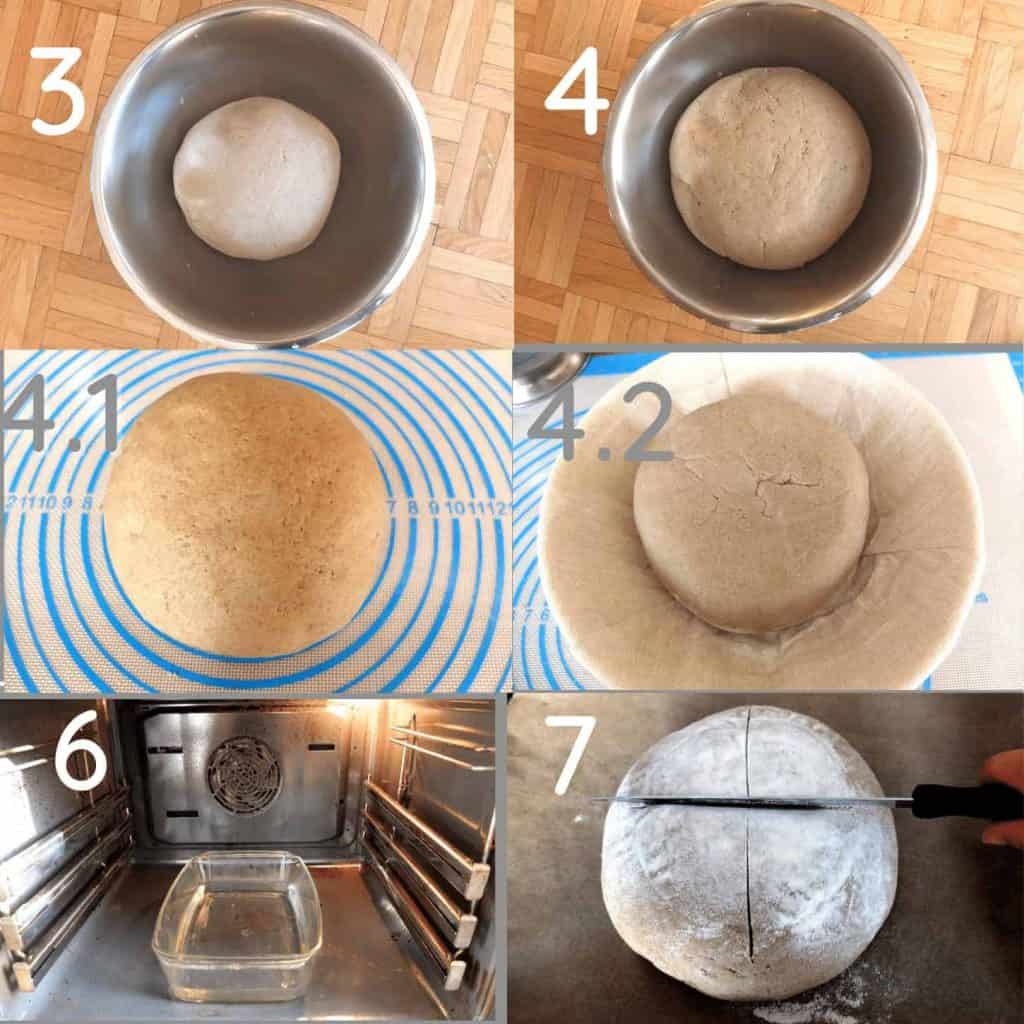
What is a proofing basket and why do I need it?
A proofing basket (Gärkorb in German) is also called bannetons or bread forms. You can get them in varying sizes - round, oval or elongated. You can use them lined or unlined. If you use them unlined you will get the pattern of the basket on the crust of your bread.
The gluten relaxes as the dough proofs, which might cause the loaves to lose shape. Using a proofing basket will help support the dough while it proofs, causing the shape to stay more stable.
The proofing basket I use is covered with a cotton sheet. Place the bread into the bowl and leave it to proof. After proofing time remove it by turning the basket upside down.
Proofing Baskets (Affiliate Link)
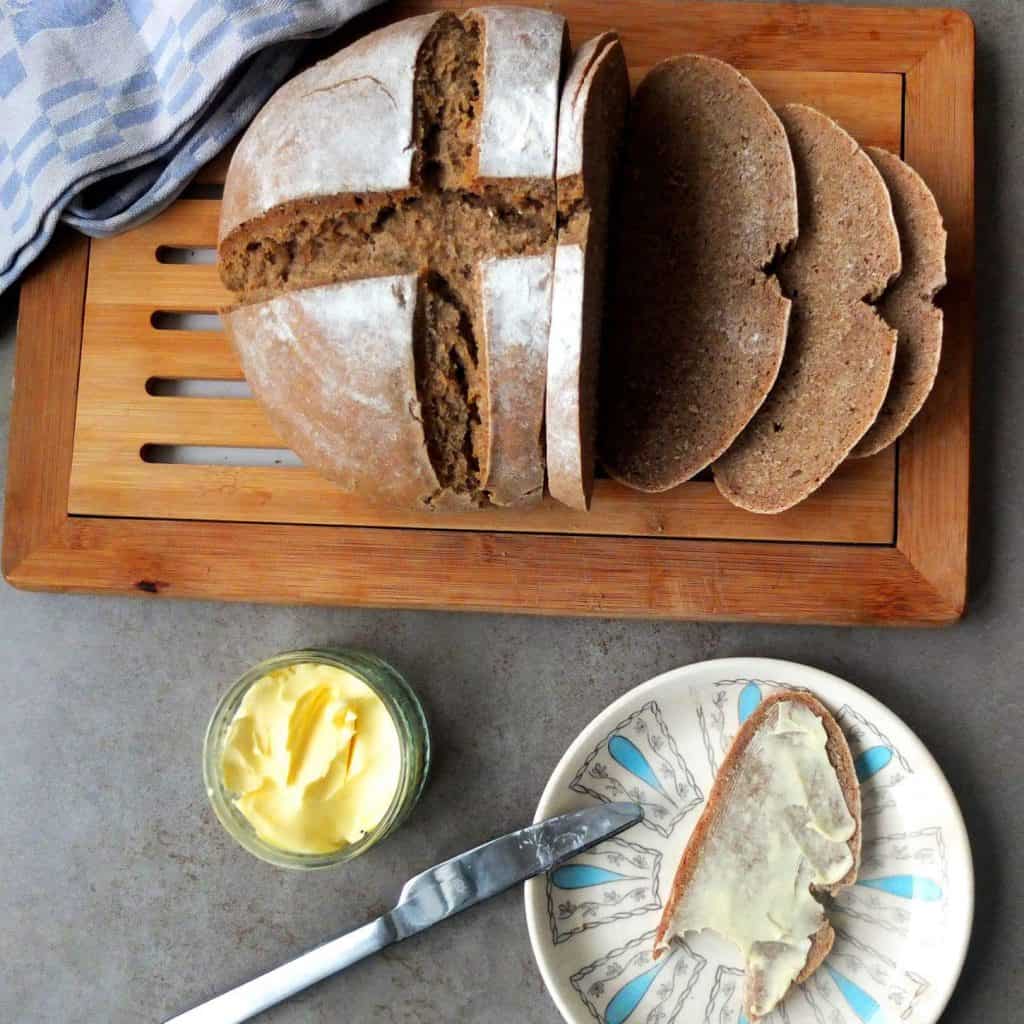
How to store German Rye Bread
Your rye bread will last 3-4 days after it has been baked. Sometimes even longer, but check that it has not molded.
It is best to store rye bread at room temperature between 18°C (64°F) and 22°C (70 °F)degrees. Store the bread in a container that allows the air to circulate, such as a bread bin, a cloth or paper bag.
Don’t keep the bread in plastic bags, because they prevent the air from circulating. This might cause the bread to mould faster.
Can I freeze German rye bread?
Yes, you can freeze rye bread and it will stay good for up to three months. Store in an airtight container. Best to write the date you made it on the container, so you can keep the expiry date in mind. I advise to freeze the bread in slices not as a whole.
Great dishes you can enjoy with this rye bread
More German Bread Recipes
- Chocolate Buns - Schokobrötchen
- Flammkuchen - German Pizza
- German Easter Bread
- Hefezopf - Braided Bread
- Berliner Donut
Recipe
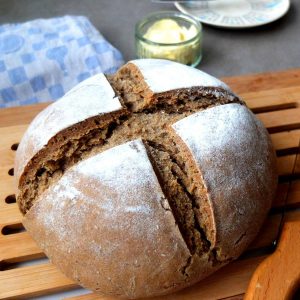
German Rye Bread with Yeast (Roggenbrot)
Ingredients
- 430 g white rye flour (15 oz)
- 220 g wholegrain rye flour (7.7 oz)
- 50 g wheat bread flour (1.7 oz)
- 7 g instant yeast 1 packet or 2 tsp
- 1 tablespoon vegetable oil
- 1 tablespoon vinegar white wine vinegar or cider vinegar
- 2 teaspoon salt
- 450 ml lukewarm water (15.2 fl oz)
Bread Spices (optional)
- 1 teaspoon caraway seeds optional
- 1 teaspoon corriander seeds optional
Instructions
- Preheat your oven to the lowest setting (mine is about 50 degrees Celsius)
- Combine the white rye flour and dark rye flour, wheat flour, water, yeast, vinegar and salt in a bowl. With a stand or hand mixer knead the dough for around 5 minutes.
- Form the dough into a ball. Slightly grease a bowl with oil (this will prevent the dough from sticking to walls of the bowl later). Place the dough ball into the bowl and cover with a tea towel. Turn off your oven and place the covered bowl into it. Leave to rise for 3 hours.
- Tip the dough back onto your work surface and knead briefly to knock out any air bubbles. If using the carraway and coriander seeds work these into the dough. Shape into a ball and place it into a bread-proofing form. Alternatively, if you don’t have a proofing form, form the bread and place it on an oven tray lined with baking parchment. Leave to rest for another 30 minutes.
- If you have a steam oven, you want to steam your bread for the first 10 minutes of baking. Alternativley fill an ovenproof dish with 1 liter of water. Set your oven to 200°C / 392°F on top bottom heat. (Not fan setting).
- Place the bowl of water at the bottom and leave to heat up for 15-20 minutes. (you should see some steam rising from the water dish)
- Place your bread loaf on an oven tray lined with baking parchment. If you are using a proofing basket, tip the content upside down. Make a cross-cut (or any other shape you fancy) about 0.4 cm on the top of your bread. Reduce the heat to 180°C/356°F. And leave to bake for around 10 minutes in the steam.
- Now open the door of the oven. Let the steam escape and then remove the water dish. Close the oven and leave to bake for a further 45 minutes. The baking time can vary according to how crispy and dark you like your crust.
- Leave to cool before consuming.





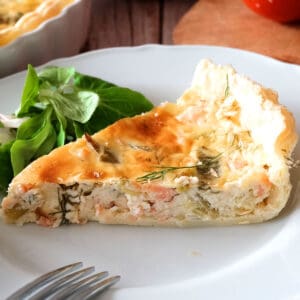
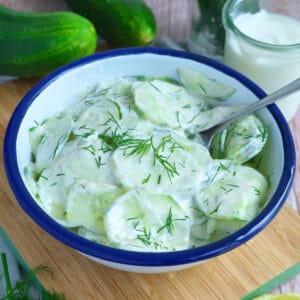
Erik
Can this recipe be used with a bread machine? I am in USA.
Marita Sinden
Hi Erik, thanks for your comment. I am not sure if it will work with a bread machine, as I do not own one. Thanks Marita
Barbara underwood
It was a tad dry but ok. Why no sugar/honey or molasses would it help the yeast to activate
Marita
HI Babara, thanks for your comment, will have another test of the recipe. It was not dry when I made it.
Melody
This was a disappointing waste of rye flour. I followed the directions and amounts exactly. The only thing I did different was that I proved my yeast in some of the water before adding it to the flour. I always do this, just to make sure my yeast is active. The directions said to add a packet of yeast, but then said it was teeth to teeth spoons. Here in the US a packet of yeast is 2 1/4 teaspoons so that’s what I used. I also threw in 50 g of sourdough starter, which should’ve also helped with the racing. From the get-go, the dough was like clay. It raised some, but it never doubled… not even after three hours. It only raised a little bit in the oven. After letting it cool for a few hours, I cut into it, and it was this dense, inedible center surrounded by a cement crust. I have over 50 years experience making bread, including sourdoughs, whole-grain, etc. I should’ve just toss this out when it came out of the mixer.
Melody
I would be so screwed. My husband says watching me slice bread is like watching a lioness rip into an antelope.
Marita
Cutting bread is definitely an art in itself.
Heather
Hi,I’m trying to make this now, but it seems so dry. I have added about 400 g of flour but it doesn’t seem possible to add more. Does this seem right?
Marita
Hi Heather, the dough is not suppose to be very wet, but if you find it too dry you can add a little extra water to it. Let me know how you get on.
Jean
Is 650 g or rye flour correct??? It is very dry, just doesn’t seem to work for me, either.
Marita
Hi Jean, that is curious. Can you send me a picture of the brand of the rye flour you are using. I will compare it to the rye flour here in Germany. I make this bread once a week so I am surprised. Thanks
Denise
Can you tell me If wheat bread flour is the same
As wholemeal flour? I am in Australia
Marita
Hi Denise no its not the same. My research tells me it called Bakers flour or Bread flour in Australia. If you cannot find it use plain or all purpose flour instead. x
Sisley White
I love rye bread and really want to try this! Thank you so much for joining up to #CookBlogShare x
Gabriela Herrera
What an art bread making is I have always been so intimidated. Thank you so much for sharing.
CookBakeLive
Pretty sure I’d have never been able to get married a long time ago because I still can’t cut bread very evenly. Lol This looks so good. I’m making to go along with dinner this week.
Kalin
I’m not a huge fan of rye bread but this looks and sounds amazing! I’d love to try “real” rye bread and not what’s sold here in grocery stores
Georgina
Can I do the recipe with only rye flour? I’m house bound and have no wheat flour at home at the moment...!
Thank you 🙂
Marita
Hi Georgina,
thanks for your comment. I am sorry I cannot help you because I never made it will 100% rye flour, but if you do try it please report back on how it went.
Best Wishes
Marita